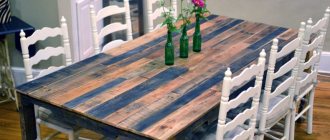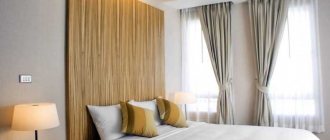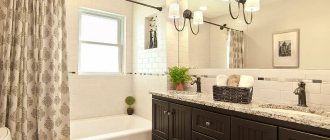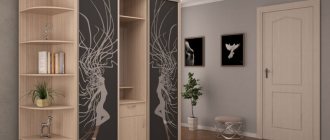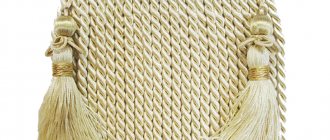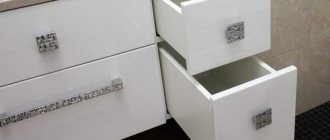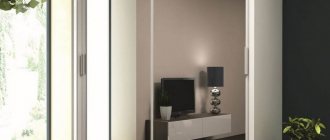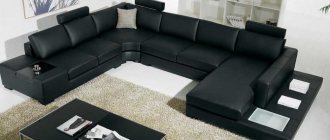Main advantages
The undeniable advantages of cornices attached to the ceiling include:
- Visual expansion of the room. Curtains that fall from the ceiling to the floor will lengthen the room and make it visually more spacious.
- Hiding existing shortcomings. A canvas that covers the wall from top to bottom will skillfully hide defects in the window opening, decorative wallpaper or the wall itself.
- Possibility of wall mounting. If desired, by purchasing several necessary brackets, such a cornice can easily turn into a wall one.
Plastic
Plastic ceiling cornice is an inexpensive, widely available option. Both ordinary, inconspicuous models and massive variations, for example, with a baguette strip, are made from this material. This design impresses with its low weight.
Installation of a plastic cornice can be done even by a non-professional; this work can be handled by a person far from construction work.
Aluminum
Aluminum ceiling cornice has been used for a long time, for many years. This is due to its relatively low price, lightness and durability.
The structure is coated on top with a special protective solution to increase wear resistance; this will maintain the original condition of the surface for a long time, even when used in rooms with high humidity.
Such curtain rods are quite flexible and can be used to construct complex curtain compositions.
String curtains
String curtains, although very popular, usually do not last long, since the curtains on them tend to sag, which hopelessly spoils the appearance of the entire room.
Therefore, they are used as a temporary option and try to be replaced at the first sign of sagging.
Metal
Metal curtain rods are very durable and can withstand even the heaviest curtains. They will fit perfectly into interiors decorated in both classic and modern, trendy style.
According to their appearance, cornices are divided into:
- hidden, this design is camouflaged, not conspicuous, used mainly to visually enlarge the room;
- decorative, serve as a separate interior detail that decorates and complements it.
Dimensions
To ensure that the curtains occupy the entire space between the parallel walls, first measure the required length. You can choose canvases 10 cm shorter. However, models that are attached tightly are also suitable. If only one window will be closed, choose curtain rods whose length exceeds the window width by half a meter. Determining the length depends on the wishes of the person.
Consider these characteristics:
- If the window is quite wide and fills the room with light, make sure that the cornice protrudes beyond the frame by 20 cm on each side.
- It is better to complement small northern windows with canvases that stand out from the overall width of the window frame by 30 cm. This way you can also hang thick curtains on the sides.
- If the room has two windows at a short distance, choose a long, solid cornice. This will make the design seem more modern.
When you attach the cornice, make sure that the tulle does not touch the heating radiators. This is quite important if the room does not have ideal geometry.
Curtains for the bedroom - 135 photos of the best new products and exclusive designs. Review of unusual design options and combinations of curtains in the bedroom interiorCurtains for suspended ceilings - features of design and selection of curtains for interiors (135 photos)
- How to decorate curtains - useful tips and options for the best decoration ideas on 115 new photos!
Forms of ceiling cornices
Round. Such cornices are a round crossbar (rod) attached to the ceiling using special fasteners. The curtains are directly attached to rings located along the entire length of the curtain.
Strings. This look is ideal for airy, weightless curtains. This system consists of a strong string stretched between a pair of fasteners.
Sticks. Stick cornices are designed according to the same system as jet cornices, but here it is not a fishing line that is mounted, but a light stick.
Profile. Profile structures are a complex system with any number of tracks for hooks, clamps, and plugs. The most common are single-row and double-row cornices.
How to choose an apartmentHow to choose furniture fittings
- DIY New Year's costume for a girl
It is also necessary to highlight the fact that for complex windows, unusual room shapes, bold design solutions, you can choose corner, rounded cornices, structures with rounded corners, etc.
Installation methods
The installation feature is another important difference between ceiling cornices and conventional wall solutions.
There are 2 installation methods
:
- open;
- closed.
Outdoor installation
- simple algorithm of actions;
- performed at the time of installation of the tension fabric;
- carried out on top of the canvas.
In order to correctly install the ceiling cornice using the open method, you must first fix a wooden beam on the concrete base, which will act as a mortgage. After the heated PVC film is stretched and secured in the baguette, thermal rings are attached to the beam locations, through which the cornice itself is later clamped with self-tapping screws.
This is what it looks like in the photo.
Hidden installation
- complex algorithm of actions;
- Suitable for high rooms only;
- helps create the effect of flowing curtains;
- greatly emphasizes the height of the ceilings;
- visually more advantageous than open.
This installation method involves creating a so-called niche
, in which a cornice fixed to a concrete base is hidden. The same airy effect is achieved due to some technological trick: a beam is attached close to the installed tire - and a baguette for PVC film is already fixed on it.
As a result, the canvas is attached to the beam, and in such an improvised niche the curtains are quietly hidden, neatly hung from the cornice you installed.
A photo of a ceiling cornice mounted in a closed way is below.
Installation recommendations
Question: “How to attach a ceiling cornice?” will worry any person who wants to install it in their apartment. However, do not be scared or worried; installation of the structure should not cause any special problems. The main thing is to follow all the recommendations specified in the product instructions, be careful and precise in your actions.
Installing a ceiling cornice to a concrete or wooden surface is the easiest option. Here you just need to make several holes in the ceiling, carefully marking their locations, then firmly secure the structure.
Attaching the cornice to the plasterboard base is a little more difficult. Here it is necessary to take care in advance about the weight of the attached structure; too massive and heavy ceiling cornices will not hold firmly, since drywall is not intended for high loads. In such a situation, it would be better to take a closer look at plastic or aluminum.
The most labor-intensive and intricate installation will be the installation of a cornice in a room with a suspended ceiling. Installation of the structure must begin before stretching the ceiling.
This is done in two ways: either the cornice is attached to specially prepared beams, which are deliberately hidden under the ceiling when it is tensioned, or the structure is fixed on the main ceiling, and the tensioned fabric is further secured to a special stand located on the cornice.
What and how to hang curtains on a balcony without a corniceHow to choose roof windows
- How to choose a mattress
Don’t be afraid to experiment; ceiling cornices are an excellent choice when decorating a window opening. They are simple to install and amaze with their diversity and versatility. This is the most modern way of attaching textiles to windows.
Species and types
The curtains are rolling on the runners. There may be many or few of them. The quantity depends on the method of fastening and on the design features of the product. There are single-row, double-row and three-row cornices. Designs with six or more runners are available. But this option for installation work is labor-intensive.
Constructions
What types of ceiling cornices are there:
- String or cable. They have two fastenings and a thin cord made of steel or nylon along which the hooks move. Suitable for minimalist style. A functional option that is inexpensive. Can be used in niches of suspended or plasterboard ceilings. In this design, the cornice is visually hidden. Decorative elements are used for this.
- Profile or tire. Plastic and aluminum are available for sale. They contain plastic grooves in the form of rails. Hooks are attached to them, which are selected according to the size of the runners. They can be produced with the insert of rotating wheels. This option is more expensive, but the movement mechanism in such structures is much easier. Curtains are attached to hooks or runners.
Nowadays, curtain rods of an outdated model - with pipes - are being actively produced. They are attached to the ceiling much easier, but look completely different. If there are complex window or balcony structures, for example, a bay window, then installation is complicated by additional installation work.
Rounded edges (baguette ceiling cornices)
The length of the bar is chosen to be several centimeters wider than the width of the window. This option is appropriate when the window is located near a wall smaller than the opposite one. Also, take a smaller strip if you plan not to extend the curtains to the edges of the walls. As such, this model does not look good with sharp corners in the room.
Plastic structures are equipped with inserts that have their own radius. They are made for turning left and right. The cabinet cornices, rounded at the edges, are equipped with a different mechanism. Curtains move on straight rails. The decorative strip placed in front of them, as a rule, has a rounded shape.
Flexible models are also available. They can be bent in any direction. Although they are not so practical and easy to use. Their only advantage is quick installation.
For bay windows (rounded)
Plastic is also called modular. This name stuck to this design for a reason. You can assemble any structure you want from elements of different lengths and widths. The only negative is that not every corner can be equipped with such an element. For a bay window, this option is one hundred percent suitable.
You can use the second design option - a flexible ceiling cornice. A polymer profile of a rigid composition is placed in a horizontal plane and bent at the required angle. The bend is made of the smallest radius, but insignificant. 10 cm is the standard permissible deflection size. But it all also depends on the manufacturer and the specific brand.
Rounded options are suitable for attics and balconies with non-standard parameters. They are successfully installed as a canopy over the bed, onto which tulle is attached. An excellent option for dividing a room into separate zones.
With decorative strip (face molding)
If curtains are hung for decoration, then decorative elements are used. For fastening, a groove is constructed or tape is glued. Attach to the front side of the finishing strip. If there is tape on the ceiling cornice, you can not attach it, but build a finishing strip. It can be made from leftover curtains or any decorative fabric that fits into the interior design.
Cornices with grooves are very popular. A decorative plastic tape is attached to them. The choice of such models is limited, since you can only focus on the options of a specific manufacturer. You can glue the end together with adhesive tape. Attach the mating part to the plastic and fasten it in the same way as above.

